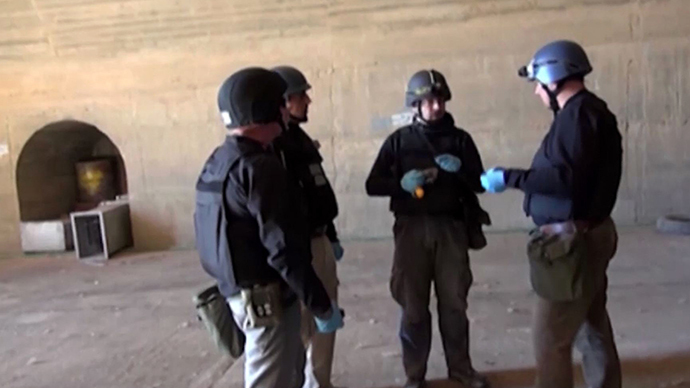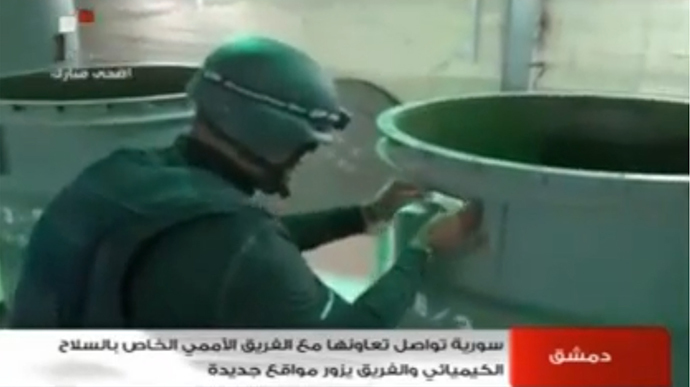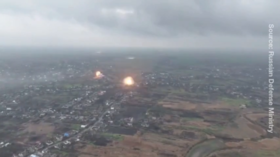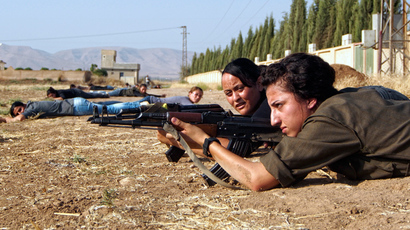Syrian chemical weapons likely to be destroyed at sea – report

The chemical weapons arsenal Syria agreed to surrender to the international community could be destroyed at sea, according to a new report citing officials familiar with the on-going negotiations.
Representatives from the Organisation for the Prohibition of Chemical weapons (OPCW), along with Western officials, told Reuters on Tuesday that the group is considering whether to destroy the chemical weapons in the ocean, either on a ship or by loading them onto an offshore rig.
“The only thing known at this time is that this is technically feasible,” an OPCW official said.
The statement comes four days after Albania refused a US request to facilitate the destruction of the chemical weapons on its soil. That decision, somewhat of a surprise from the American NATO ally, was met with cheers from crowds of protesters who had gathered outside the prime minister’s office to demonstrate against the possibility.
Experts told Reuters that, despite Japan’s previous foray into destroying arms at sea, such an enterprise would be incredibly intricate and dangerous.
“There are discussions about destroying it on a ship,” one US official said.
The first step in any such process would involve removing the more than 1,000 tonnes of toxic material out of Syria as the civil war that has engulfed the country continues to rage and spill over into the neighboring region, in particular Lebanon.
OPCW investigators have examined the sarin, mustard gas, and other chemicals under the control of President Bashar Al-Assad and his government. They determined last week that the majority of the deadliest chemicals should be moved out of Syria by the end of 2013 and eliminated by mid-2014.
Assad agreed to surrender the weapons and join the international prohibition on chemical weapons after US President Obama threatened a limited bombing campaign in response to a sarin gas attack that is alleged to have killed over 1,000 Syrian civilians.
The United Nations Security Council authorized the 2014
destruction of the weapons and charged a joint UN-OPCW panel with
overseeing the plan as it is carried out. The OPCW executive
council met Friday in The Hague, when the plan to remove “the
most critical chemicals” from Syria was finalized.

OPCW Director General Ahmet Umzucu said in a statement that the plan was a “clear road map” to meet the aforementioned deadline.
“This next phase will be the most challenging, and its timely execution will require the existence of a secure environment for the verification and transport of chemical weapons,” he said. “Continuing international support and assistance for this endeavor will remain crucial.”
When Albanian Prime Minister Edi Rama said no to the request – citing “no capacity of any kind pertaining to the transport and technological processes involved” – he outlined many of the same problems that the OPCW and UN must now consider.
Any action will certainly need to be more intricate than when the Japanese government destroyed weapons leftover from World War II in 2004-2006. In doing so, the Japanese set up a disposal plant on a floating platform.
The Syrian weapons will produce liquid waste that those Japanese weapons did not. It also makes hydrolysis, a neutralization process that involves adding water to the chemical, much less likely.
“If you use hydrolysis or incineration, there will be liquid waste,” Ralf Trapp, an independent chemical disarmament specialist, told Reuters. “So there will be problems with regard to environmental pollution that need to be addressed.”
Another scenario Trapp brought to mind is Bikini Atoll, the 23 islands spanning 3.4 square miles the US government used as a testing ground for nuclear weapons during the Cold War.
“It had to come up as an option at some point in time, given the circumstances,” Trapp said of the offshore destruction plan. “Technically it can be done, and in fact at a small scale it has been done.”














